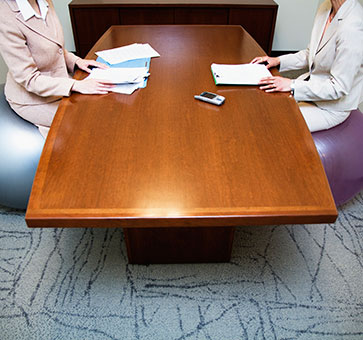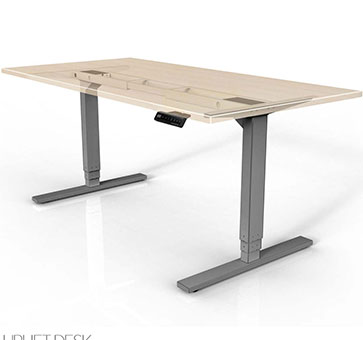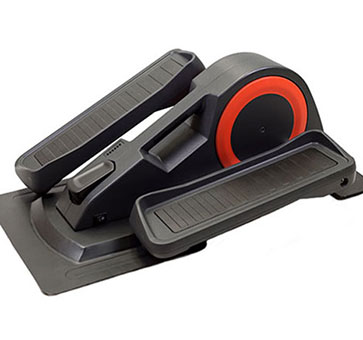Take a Stand! The Easy Cure for "Sitting Disease"
By Blake Miller
Click Here to Manage Email Alerts
More and more research is showing the health hazards of time spent sitting, yet more and more of physicians’ work involves staring at a computer screen. Physician heal thyself: by finding ways to stand up more and sneak in movement throughout your day.

Dr. Hanley’s assumption was wrong, of course. Research at the University of Texas Southwestern Medical Center, reported last year in the Mayo Clinic Proceedings, found that just two hours of sedentary behavior can be just as bad for you as 20 minutes of exercise can be beneficial. Even worse, Indiana University scientists, publishing in the April 2015 issue of Medicine & Science in Sports & Exercise, found that the negative effect on cardiorespiratory fitness of six to seven hours of sitting was inversely similar in magnitude to the beneficial effect of one hour of moderate-intensity exercise.
Dr. Hanley is far from alone in his concerns regarding so-called sitting disease, the term used to describe the harmful effects of a sedentary lifestyle. Research is showing that too much sitting can increase the risk of cardiovascular disease, type 2 diabetes, obesity, and even death.
Unfortunately, these reports are coming as doctors’ work requires more and more desk time. According to a 2014 survey by Physicians Foundation, doctors now spend 20 percent of their time on non-clinical paperwork. Like the majority of Americans these days, doctors are spending more of their work time at a desk, in front of a computer. The average American is now sedentary for up to 60 percent of the day, and many Americans spend their entire working day sitting behind a desk.

Photo courtesy of FitnessCubed.
THE SIT-UATION
“Sitting can be lethal to your health,” says David Katz, MD, director of Yale University’s Prevention Research Center. “Sitting seems like a very natural position these days since we spend so much of our lives doing sedentary things like driving to work or sitting in front of a computer. In modern society, we move too little, we spend too much time sitting, and it makes sense to fix that by fitting motion into your day.”
There's evidence that people, especially doctors, are trying to do just that. Dr. Hanley says that recently he’s seen more of his colleagues at Carolinas HealthCare System using standing desk in lieu of office chairs. “The tide is certainly changing when it comes to utilizing these tools during the workday,” says Dr. Hanley, who admits that at first some of his colleagues were skeptical of the benefits. “People would walk into my office and make fun of me sitting and bouncing on an exercise ball while taking a conference call. Now, those same people are the ones who come into my office wanting to try it. The biggest benefit is that I feel my productivity and energy levels are improved, too.”
Physicians want to be health role models for their patients, but how can they do that when desk work keeps them locked down? “For us, as physicians, we spend a lot of our training in front of the computer,” explains Seth Martin, MD, Pollin Cardiovascular Prevention Fellow at Johns Hopkins Ciccarone Center for the Prevention of Heart Disease in Maryland. “We go out on rounds in the morning, sometimes we have sitting rounds. Much of the rest of the day, you’ll be sitting by a computer, typing up notes while sitting.”
GET ON YOUR FEET
The simplest way to curb and even eliminate the risks of sitting disease entirely is to simply move more, sit less. “If your normal routine includes long periods of sitting, you’ve got to disrupt it,” says Sanjay Bhojraj, MD, a board-certified cardiologist with Mission Heritage Medical Group, a member of the St. Joseph Hoag Health Alliance in Mission Viejo, California. “Taking the stairs, stretching at your desk, going for short walks—even around your office—can help decrease your risk of suffering negative health consequences.”
David Katz and his colleagues at Yale created A-B-E for Fitness (Activity Bursts Everywhere), an evidence-based program designed on the idea that small bursts of physical activity spread over the course of the day is just as beneficial as longer daily bouts of exercise. The program (abeforfitness.com) provides free three- to eight-minute videos of activity bursts that you can do throughout your day.
Beyond disrupting your everyday routine, there’s new technology that can help you minimize the risks of sitting disease. At St. Joseph Hoag Health Wellness Center, members can take conference calls from a treadmill provided free of charge. Dr. Martin now does much of his reading while walking on a slow-moving treadmill at the gym. (For more move-encouraging products, see Stand Up To Sitting Disease, below.)
The good news about sitting disease is that it’s preventable and there are fairly simple ways to combat it. “Maintaining a healthy lifestyle isn’t really ‘difficult’ or ‘easy,’ in my opinion,” says Dr. Bhojraj. “It simply requires awareness of an issue and the right mindset to address it.” In other words, just get up and move it!
*****
STAND UP TO SITTING DISEASE
These products will help get you up and moving.
1. Uplift 900 Sit-Stand Ergonomic Desk

Uplift 900 Sit-Stand Ergonomic Desk
Sure, a DIY standing desk is more affordable. But when there's an option for a standing desk that you can easily customize, like the UPLIFT 900 Sit-Stand Ergonomic Desk, it's a good excuse to invest in the name of good health (and posture). Adjust the height easily via motorized legs and choose from various components such as keyboard trays and casters to make it mobile. From $699, www.thehumansolution.com
2. Cubii Under-Desk Elliptical

Cubii Under-Desk Elliptical
If you simply can't move from your desk due to paperwork or all-day conference calls, consider moving while sitting. Cubii is a compact elliptical machine that fits under a desk and allows you to pedal gently while sitting, burning an estimated 120 calories per hour. Cubii integrates with all fitness tracking devices, including Fitbit, Jawbone, and Fitbug. The 20-pound machine is available in black or silver. $319 plus shipping, www.fitnesscubed.com
3. Stand Up! The Work Break Timer App

The best way to negate the risks of sitting disease is to move once an hour. But sometimes work, life, and patients get in the way. This simple app is surprisingly effective in motivating you to get up from your workspace as frequently as you set the timer. Unlike alarms on your phone, you can set a time range (8 a.m. to 6 p.m.) and interval (every 45 minutes, for example) so that you're reminded throughout the day to move more, sit less. Free, iTunes
And now you have no excuse!
